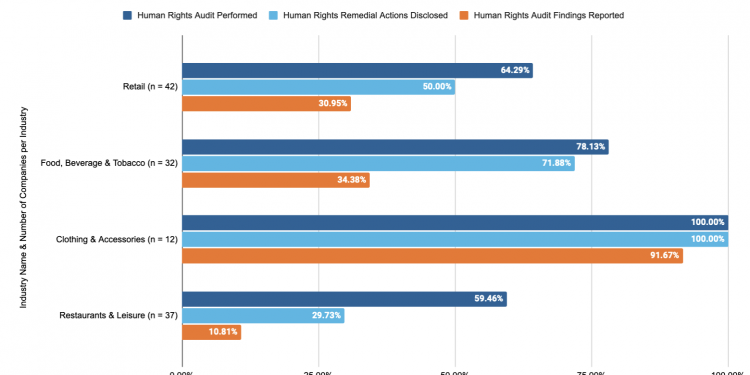Contract Workers Need a Just Recovery: Lessons from Microsoft and Mercer on the Future of Work
Each year, we survey the American public to learn their views on business today, and we’ve learned that Americans consistently agree – year after year – that the top priority for companies should be their workers. And the public doesn’t necessarily distinguish between different types of workers – whether full-time, part-time, or contracted – showing that temporary, contract, and vendor (TVC) workers should be prioritized alongside a company’s permanent workforce.
Since 2018, JUST Capital has been working to better understand how companies think about their TVC workforces – and we’ve found that corporate leaders continue to grapple with key questions around these workers. Concretely: are TVC workforces a risk to be managed, or a potential asset that hasn’t been properly explored?
Over the last year, the impacts of COVID-19 have accelerated these questions – with companies asked to carefully consider how to support their contract workforces through the pandemic, and with the world of work writ-large on the cusp of transformation, as companies grapple with whether and how to reopen their workplaces and what a return to “normal” might look like for their employees. With TVC workers an increasingly urgent topic for corporate America, we recently sat down with Teresa Huston, Vice President and Deputy General Counsel at Microsoft, and Tauseef Rahman, Partner at Mercer, to explore their work on these issues.
At the start of the pandemic, #1 Most JUST company Microsoft committed to continue paying its contractor workers – many of whom work on-site at the company’s campus in Seattle – and the company continues to compensate these employees today. Huston explained Microsoft’s journey to this decision, which began long before the pandemic with a path that included a seminal lawsuit and now has led to Microsoft extending key benefits to its temporary employees. “We learned some pretty hard lessons from that case,” Huston shared – and in the years since, Microsoft has become a pioneer on these issues, requiring its vendors to offer paid sick leave and paid parental leave to their workers. With these foundations in place, Microsoft’s choice to continue paying its TVC workforce was a natural next step, and served once more as a model for how corporate leadership can and should support these employees.
Mercer – a consulting firm whose mission serves, in part, to help companies redefine the world of work – often explores the issues of TVC workforces in conversation with its clients. In March of 2020, Mercer learned that about ⅔ of companies say they employ contractors – but also found that the majority did not provide compensation during the pandemic. Rahman explained that the nature of contract work holds significant risk for TVC workers, particularly during more challenging times, but emphasized that this moment represents a significant opportunity to ask “Are there different ways to work for a company?”
Key takeaways are emerging from our conversations with companies – including Microsoft and Mercer – about how corporate leaders should consider their TVC workforces, as we continue to talk about building a more resilient economy in the future:
1. Remember that contractors and full-time employees are part of the same workforce.
In recent years, more and more contract workers have become core to companies’ operations – sitting alongside their permanent counterparts as colleagues and taking part in work that is central to their company’s operation and mission. With Americans expecting companies to prioritize their workers, corporate leaders must consider how they support not just their employees, but the contract workers who share space with them and contribute considerably to their collaborative work. Huston emphasized that, while the unique legal and contractual considerations of contract workers can’t be ignored, corporate America needs to move away from the mindset that contractors are “a risk to be managed” and toward a more integrated understanding of how TVC workers contribute to the resiliency of their business, shape the experiences of the permanent workforce, and advance the company’s mission through their efforts.
2. We need a clearer picture of our nation’s contract workforce.
Before we can truly consider what might need to change for America’s contract workforce, we need to understand the current state of play for these workers. Human capital disclosure – particularly around demographic issues – is becoming increasingly important across corporate America, but TVC workforces present unique challenges when it comes to disclosure and transparency. With many contract workers employed through vendors, Huston emphasized that there are different legal considerations at play – in regards to both the demographics of these workers and even what kinds of jobs they hold – when asking companies to share details on their contract workforce. Furthermore, Rahman shared that contract hiring and human capital issues might not even be centralized with HR departments, making it difficult to collect information about these workers and factor them into strategic workforce planning. In the coming years, a core question for corporate America must be around how we build a clear and consistent portrait of our nation’s – and each company’s – contract workers – so that we might better understand what is working and what is not.
3. Setting specific contract standards benefits your employees and your bottom line.
Over the years, our research has shown that treating workers well not only benefits a company’s employees but its bottom line. Understanding, again, that contract and permanent employees are part of the same workforce, the unique challenges faced by TVC workers can negatively impact their own productivity as well as the productivity of their permanent colleagues – and the challenges of retention and retraining contract workers can significantly slow or hamper a company’s operations. Huston emphasized that, for Microsoft, “Making decisions to be responsible and aware has been good for our business,” a guiding principle that led them to set specific contract standards for their TVC workers – like paid sick leave and parental leave – that allow these employees to be more present and effective members of Microsoft’s overall workforce and to contribute more significantly to the company’s growth.
4. Support for contractors today means a safer, smoother transition tomorrow.
As we look ahead to the reopening of businesses across corporate America, the question of how contract workers are supported today can profoundly impact our eventual return to work. Most tangibly, there are key questions of occupational health and safety – if paid sick leave is not available to contract workers, the risks of outbreak are potentially greater, and the ways that contract and permanent employees share space can impact critical health concerns. But there are also important questions about operational resiliency – if an entire contract workforce has been laid off, corporate leaders face significant challenges to resuming normal operations and scaling back up, needing to rehire and retrain workers across many areas of their business. Finally, it’s critical for companies to recognize how decisions around their contract workforces can have tremendous impact on their communities. Huston shared that, for Microsoft, a major way that the company contributes to its community is by providing jobs to the people who live there. “We really are responsible for how our region emerges from this catastrophic event,” she emphasized – suggesting that support for contract workers shapes not only the future of our nation’s businesses, but the future of our nation’s communities.
5. It’s time to rethink the fundamental nature of employment.
Embedded within this question of how we rebuild following the pandemic is the consideration of what the future of work writ-large might look like. Rahman hypothesized that our “full-time-or-bust” mentality might become a thing of the past, as more employees core to companies’ operations are employed on a contract basis and we begin to more deeply question whether there are different ways to work for a company. And questions of flexibility and types of employment are relevant not just to lower-wage, lower-skill work, but must be central in how we think about all our nation’s workers. This moment represents an opportunity for companies to consider, coming out of the pandemic, what groundwork they might lay now to ensure that their full supply chain is resilient and connected to the operations and purpose of the broader company.
Corporate leaders are increasingly seen as societal leaders, responsible for what’s happening not only within their own organizations but within their communities and the world of work writ-large. It’s clear, and becoming clearer, that these issues are not limited to the on-demand economy or to lower-skilled workers, but to TVC employees across industries and the wage ladder who have become deeply integrated in their company’s core operations. In our ongoing conversations with C-suite leaders – focusing on issues like worker financial well-being and racial equity – we will continue to apply this lens of consideration, asking how a company’s TVC workforce must shape strategic decisions around these issues, as well as the future of work overall. There’s a real question about mindset-shift on this issue, where leaders must begin to ask and understand their contract workers. In the meantime, we will continue to contend with the fragmentation of America’s workforce, and the implications that fragmentation has for our nation’s businesses, the communities in which they operate, and the world of work overall.
Explore more of JUST Capital’s work on the TVC workforce here, and watch the full conversation with Microsoft and Mercer below:






